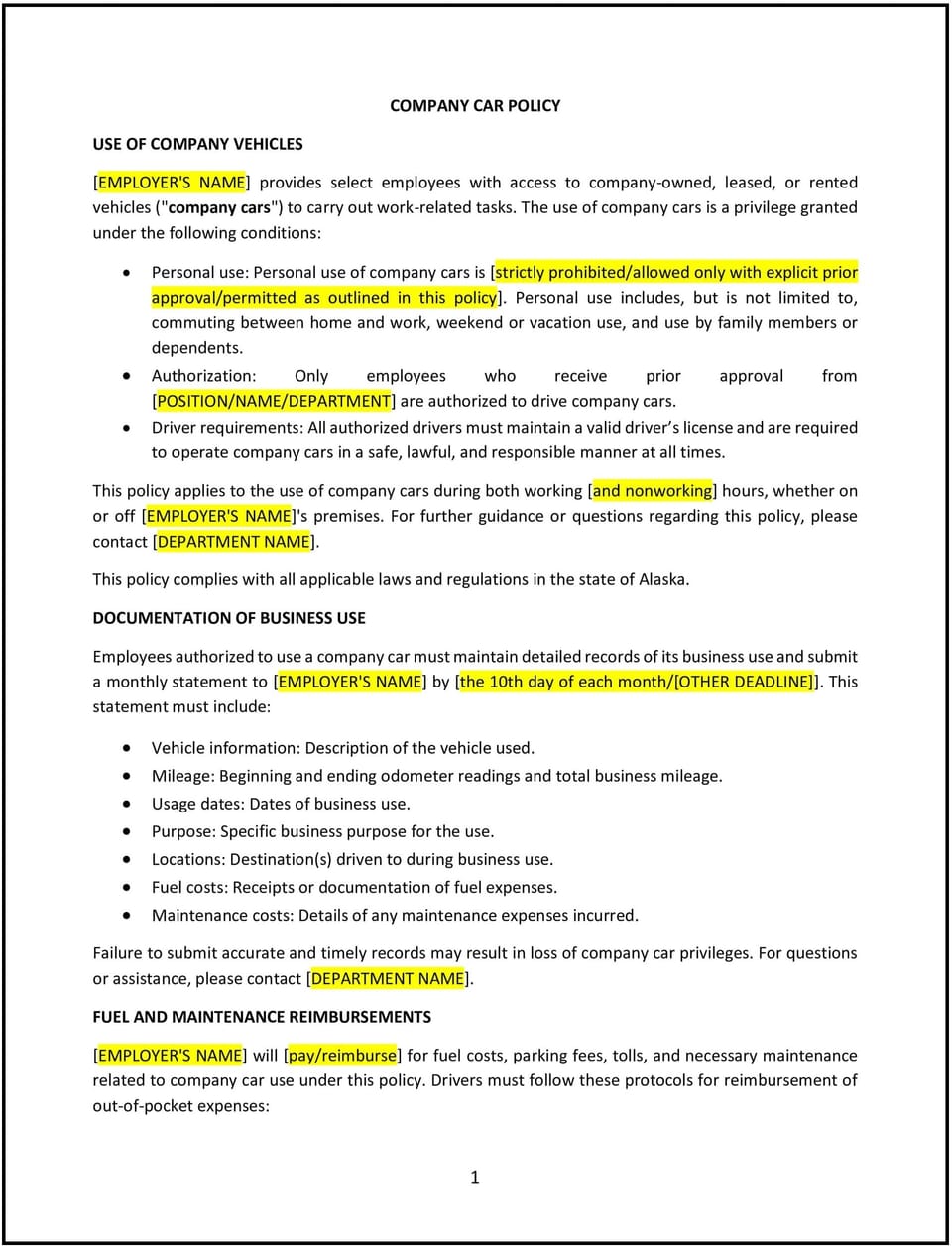Company car policy (Alaska): Free template

Company car policy (Alaska)
In Alaska, a company car policy provides clear guidelines for the use, maintenance, and responsibilities associated with company-owned or leased vehicles. This policy ensures that employees understand expectations regarding vehicle use while protecting the company from potential risks and liabilities. By implementing this policy, businesses can promote safe driving practices and maintain compliance with insurance and legal requirements.
Alaska’s challenging terrain, remote locations, and harsh weather conditions may require specific provisions in the policy, such as guidelines for winter safety or vehicle use in rural areas.
How to use this company car policy (Alaska)
- Define eligibility: Clearly state which employees or roles are eligible for company car use, such as those requiring frequent travel or client visits.
- Outline acceptable use: Specify when and how company cars can be used, including work-related activities and whether limited personal use is permitted.
- Address maintenance responsibilities: Provide guidelines for routine maintenance, inspections, and reporting of vehicle issues to ensure safety and functionality.
- Include safety requirements: Emphasize adherence to traffic laws, use of seat belts, and guidelines for safe driving in Alaska’s unique conditions, such as icy roads or remote areas.
- Clarify liability: Detail employee responsibilities in the event of accidents, including reporting procedures, insurance coverage, and out-of-pocket costs for unauthorized use.
Benefits of using a company car policy (Alaska)
A company car policy offers several advantages for businesses in Alaska. Here’s how it helps:
- Promotes safety: Encourages safe driving practices and outlines clear procedures for handling accidents or emergencies.
- Supports compliance: Helps meet legal and insurance requirements, reducing the risk of liability for the company.
- Reduces misuse: Establishes clear rules for acceptable use, minimizing the risk of unauthorized or inappropriate use of company vehicles.
- Maintains vehicle condition: Ensures vehicles are properly maintained and inspected, extending their lifespan and reducing repair costs.
- Enhances operational efficiency: Provides employees with reliable transportation for work-related tasks, improving productivity and service delivery.
Tips for using a company car policy (Alaska)
- Include seasonal safety guidelines: Provide specific instructions for driving in Alaska’s winter conditions, such as carrying emergency kits and using winter tires.
- Set clear boundaries for personal use: Clearly define whether personal use is allowed and, if so, specify any restrictions or reimbursement requirements.
- Offer training: Provide safe driving training, especially for employees unfamiliar with Alaska’s unique driving conditions or operating company vehicles.
- Monitor vehicle use: Use mileage logs or GPS tracking to ensure vehicles are used appropriately and efficiently for business purposes.
- Regularly review the policy: Update the policy as needed to reflect changes in insurance coverage, business needs, or local regulations.
Q: Who is eligible to use a company car under this policy?
A: Eligibility is typically determined by job role and the necessity of a vehicle for work-related tasks. The policy should clearly define which positions qualify.
Q: Can employees use company cars for personal activities?
A: Limited personal use may be allowed, but the policy should specify any restrictions, reimbursement requirements, or prohibited activities.
Q: What steps should employees take after an accident involving a company car?
A: Employees must report the accident immediately to their manager and follow the company’s procedures for insurance claims, documentation, and repairs.
Q: How can I ensure company cars are properly maintained?
A: Require employees to follow maintenance schedules, report issues promptly, and conduct regular inspections to ensure vehicles remain safe and functional.
Q: What safety measures should be included in the policy for Alaska?
A: Include guidelines for winter driving, such as using snow tires, carrying emergency supplies, and avoiding travel during severe weather conditions.
This article contains general legal information and does not contain legal advice. Cobrief is not a law firm or a substitute for an attorney or law firm. The law is complex and changes often. For legal advice, please ask a lawyer.


